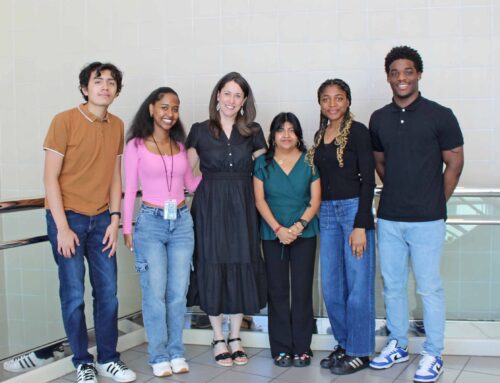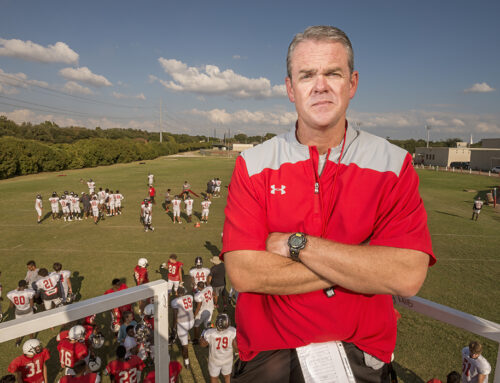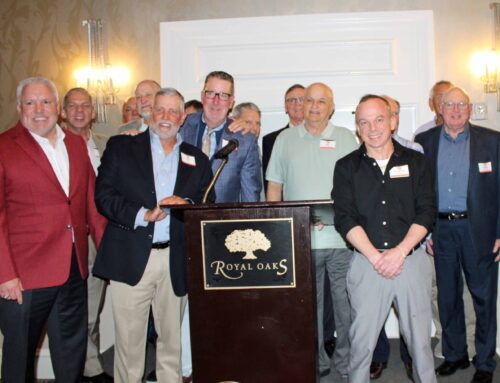Lake Highlands High School is a district 5A sports competitor two, a recent winner of the prestigious national blue ribbon award and had a 2002 graduating class of 516 students.
Back in September 1960, however, the school was starting from scratch.
That year, 135 students were given a choice. They could either follow their upperclassmen on to the Richardson Junior-Senior High School – to which they had been proceeding for years – or they could become part of a new initiative named Lake Highlands Junior-Senior High School.
Today’s LHHS began as a state of mind rather than as a tangible place. Students watched the construction of the building that now houses LHHS, but their Wildcat memories actually lay in the halls and classrooms of Lake Highlands Junior High School.
The class of 1964 didn’t mind. By the time they arrived at the semi-constructed junior high with a plan to stay for four years, the students were ready to settle anywhere. They had been on the move since the sixth grade, spending that year at Lake Highlands Elementary, and their seventh grade year at neighboring Wallace Elementary.
“It created a bond for us,” says Chuck Carona, graduate of the Class of ’64 and most recently the principal of J.J. Pearce High School. He’s now director of freshman programming for Richardson ISD. Carona was a member of the first football team and the captain of the first basketball team.
“There’s only one group that gets to be the first,” he says.
It’s difficult to imagine a day when LHHS’ presence wasn’t immediately known in our neighborhood, but according to Suzanne Schwenn, a class of ’64 graduate who has taught with RISD for 28 years (including two at LHHS), her class was largely unaware of the legacy they would be leaving.
“We never even thought about the traditions we were starting or what significance they would have someday to other students. We just wanted our peers at other schools to know that Lake Highlands existed,” Schwenn says.
Classmates set about creating a school identity, participating in what would one day become accepted rituals, as well as some dated and, eventually, jettisoned ones.
“We were so sheltered,” says Ann Burke, who recently retired from a 31-year career as a fifth- and sixth-grade teacher at Lake Highlands Elementary and was once a member of the Future Homemakers Of America club. Carona agrees, saying the students grew up during what he calls the “Beaver Cleaver era” but were also further coddled by having been spared the experience of upperclassmen to taunt and tempt them.
“Thinking back on what my kids went through with older influences, good or bad, we had none of that,” Burke says.
The Class of ’64 may not have had to deal with older kids – they were the oldest students in a school that went down to seventh graders – but they also didn’t have a few other things, such as a cafeteria, air conditioning, a mascot, school colors or an alma mater.
“We were the ones to determine the high school mascot and the colors of red and white,” Schwenn says. “A seventh-grade student named Margaret Johnson wrote the words to the alma mater that are still used today.”
Schwenn says she and two Highlandette friends – Judy Faller and Bonnie Jagmin – wrote the words to the school’s fight song during a bus trip back to school after a football game. Back then, joining the Highlandettes was a choice the girls made themselves, Burke says.
“Just about all of us who wanted to be were on it,” Burke says. “They had to pick from the lower grades because there were no upperclassmen. My sister was on it with me – she was in the eighth grade, and I was in 10th. But we learned and had a lot of fun.”
Schwenn says she has yet to actually witness a student nowadays singing the words to the fight song she helped pen, but remembers she and her classmates sang them all the time.
“Every time I hear the alma mater or fight song played, I experience a flashback to another time,” Schwenn says.
In that moment, what Schwenn remembers has less to do with physicalities than with notions.
“Although I attended LHHS in a different building, my memories lie with the friendships I made and in the traditions I witnessed being created,” Schwenn says.
Or, like Carona, she may also be remembering the simple school and its fitting accommodations.
“We’d sit on the back porch and try to get cool after football games,” says Carona about what people did when there was no air-conditioning in the school. “We didn’t know any different.”
The LHHS football team played its first varsity football game – without even a 1A designation – against a team from Anna, Texas, at the Greenville Avenue Stadium in Richardson. The Wildcats won 16-12.
“Lake Highlands was a small growing town,” says Carona, who was the assistant principal at LHHS from 1981-86. “It was a one-school town. We all went to sporting events and plays.”
“We were a small community kind of away from others. We were just together,” says Burke, whose four daughters also attended LHHS.
“What a different world we lived in,” Schwenn says. “Today’s students have to make wise choices in challenging situations we either did not face until we were much older or never had the opportunity to confront.”
But their admiration for the savvy of today’s teenagers shouldn’t be mistaken for envy. The members of the class of ’64 know how good they had it.
“When the school is as competitive as it is now,” Burke says, “it’s harder to find your niche. There isn’t a lot of down-home stuff anymore because the school is so big. I’m not sure they have as much fun as we did.”
Some also might argue that the standards of fun have changed.
“We thought we were being brave wearing T-shirts to school one day,” laughs Carona, “but we were really afraid to do anything else.”
Possibly their restraint was out of fear, or possibly it was just out of respect, the latter being something they still feel to this day.
“Sue Passmore was the third person I called when I became principal,” says Carona of his high school English teacher and fellow neighborhood resident. “High school is a special time in our lives.”





